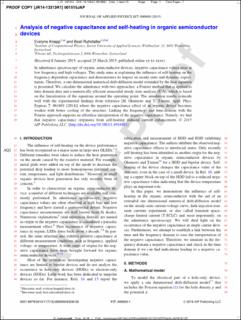Please use this identifier to cite or link to this item:
https://doi.org/10.21256/zhaw-1992Full metadata record
| DC Field | Value | Language |
|---|---|---|
| dc.contributor.author | Knapp, Evelyne | - |
| dc.contributor.author | Ruhstaller, Beat | - |
| dc.date.accessioned | 2018-06-15T11:45:52Z | - |
| dc.date.available | 2018-06-15T11:45:52Z | - |
| dc.date.issued | 2015-03 | - |
| dc.identifier.issn | 0021-8979 | de_CH |
| dc.identifier.issn | 1089-7550 | de_CH |
| dc.identifier.uri | https://digitalcollection.zhaw.ch/handle/11475/6929 | - |
| dc.description.abstract | In admittance spectroscopy of organic semiconductor devices, negative capacitance values arise at low frequency and high voltages. This study aims at explaining the influence of self-heating on the frequency-dependent capacitance and demonstrates its impact on steady-state and dynamic experiments. Therefore, a one dimensional numerical drift-diffusion model extended by the heat equation is presented. We calculate the admittance with two approaches: a Fourier method that is applied to time domain data and a numerically efficient sinusoidal steady state analysis (S3A), which is based on the linearization of the equations around the operating point. The simulation results coincide well with the experimental findings from reference [H. Okumoto and T. Tsutsui, Appl. Phys. Express 7, 061601 (2014)] where the negative capacitance effect of an organic device becomes weaker with better cooling of the structure. Linking the frequency- and time-domain with the Fourier approach supports an effortless interpretation of the negative capacitance. Namely, we find that negative capacitance originates from self-heating induced current enhancement. | de_CH |
| dc.language.iso | en | de_CH |
| dc.publisher | American Institute of Physics | de_CH |
| dc.relation.ispartof | Journal of Applied Physics | de_CH |
| dc.rights | Licence according to publishing contract | de_CH |
| dc.subject | Organic semicondutor | de_CH |
| dc.subject | Negative capacitance | de_CH |
| dc.subject.ddc | 621.3: Elektro-, Kommunikations-, Steuerungs- und Regelungstechnik | de_CH |
| dc.title | Analysis of negative capacitance and self-heating in organic semiconductor devices | de_CH |
| dc.type | Beitrag in wissenschaftlicher Zeitschrift | de_CH |
| dcterms.type | Text | de_CH |
| zhaw.departement | School of Engineering | de_CH |
| zhaw.organisationalunit | Institute of Computational Physics (ICP) | de_CH |
| dc.identifier.doi | 10.21256/zhaw-1992 | - |
| dc.identifier.doi | 10.1063/1.4916981 | de_CH |
| zhaw.funding.eu | No | de_CH |
| zhaw.issue | 13 | de_CH |
| zhaw.originated.zhaw | Yes | de_CH |
| zhaw.publication.status | publishedVersion | de_CH |
| zhaw.volume | 117 | de_CH |
| zhaw.publication.review | Peer review (Publikation) | de_CH |
| Appears in collections: | Publikationen School of Engineering | |
Files in This Item:
| File | Description | Size | Format | |
|---|---|---|---|---|
| 2015_ruhb_Analysis_of_negative_capacitance.pdf | 1.07 MB | Adobe PDF |  View/Open |
Show simple item record
Knapp, E., & Ruhstaller, B. (2015). Analysis of negative capacitance and self-heating in organic semiconductor devices. Journal of Applied Physics, 117(13). https://doi.org/10.21256/zhaw-1992
Knapp, E. and Ruhstaller, B. (2015) ‘Analysis of negative capacitance and self-heating in organic semiconductor devices’, Journal of Applied Physics, 117(13). Available at: https://doi.org/10.21256/zhaw-1992.
E. Knapp and B. Ruhstaller, “Analysis of negative capacitance and self-heating in organic semiconductor devices,” Journal of Applied Physics, vol. 117, no. 13, Mar. 2015, doi: 10.21256/zhaw-1992.
KNAPP, Evelyne und Beat RUHSTALLER, 2015. Analysis of negative capacitance and self-heating in organic semiconductor devices. Journal of Applied Physics. März 2015. Bd. 117, Nr. 13. DOI 10.21256/zhaw-1992
Knapp, Evelyne, and Beat Ruhstaller. 2015. “Analysis of Negative Capacitance and Self-Heating in Organic Semiconductor Devices.” Journal of Applied Physics 117 (13). https://doi.org/10.21256/zhaw-1992.
Knapp, Evelyne, and Beat Ruhstaller. “Analysis of Negative Capacitance and Self-Heating in Organic Semiconductor Devices.” Journal of Applied Physics, vol. 117, no. 13, Mar. 2015, https://doi.org/10.21256/zhaw-1992.
Items in DSpace are protected by copyright, with all rights reserved, unless otherwise indicated.